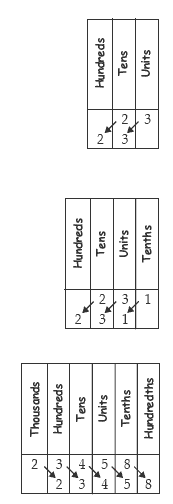Know what happens when a number is multiplied or divided by a power of 10.
Number Framework Stage 8
“Janet solved this problem by adding a zero: There are 10 sacks of sugar each with 23 kg of sugar in them. What is the total weight?” Discuss why 10 x 23 = 230.
“Janet now measures the weight to greater accuracy and finds each bag more precisely weighs 23.1 kg.”
Discuss the answer to 10 x 23.1. At this stage common wrong answers are 23.10 and 23.01. Both show the “add zeros” rule failing badly. Allow the students to work out 10 x 23.1 on a calculator. It gives 231. Discuss who is correct; them or the calculator? Revisit problems like 10 x $23. Discuss the fact that the
20 $10 notes give two $100 notes and the 30 $1 notes give three $10 notes.
Record the table on the board or modelling book and discuss the fact that multiplying by 10 moved the digits one place to the left.
(In the table, a zero is not needed, but it has to be added when there is no table to differentiate the units.)
Repeat with a chart that has tenths in it. Discuss why 10 x 23.1 is two hundreds, three tens, and one unit (10 tenths). So, again, the digits move.
Repeat with similar problems.
Repeat with multiplying by 100, which moves digits two places to the left.
Repeat with multiplying by 1 000, which moves digits three places to the left.
Activity – Division
Problem: “Simon pays $240 for 10 DVDs. What does one DVD cost?” Model $240 on money. Discuss why dividing 240 by 10 moves the digits one place to the right.
Problem: “2 345.8 kg of a chemical is packed into 10 containers.
What is the weight in each container?” Discuss what a calculator would show for 2 345.8 ÷ 10. Let the students check this on a calculator. Copy the table onto the board or modelling book.
Discuss why the digits are moving one place to the right even for the decimal part. Record this in the table. So 2 345.8 ÷10 = 234.58.
Repeat for 65.8 ÷ 10, 5.18 ÷ 10, 455 ÷ 10, 1 260 ÷ 100, 63 ÷ 100, 6.8 ÷ 100, 2 345 ÷ 1 000, 200.9 ÷ 1 000 ...
